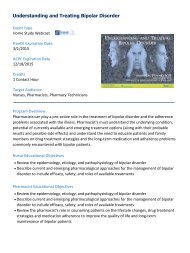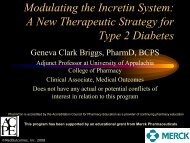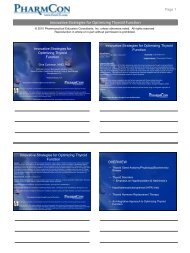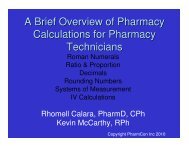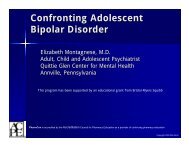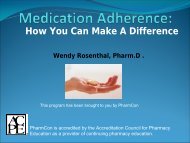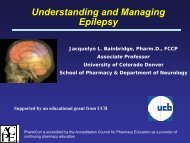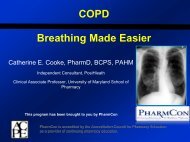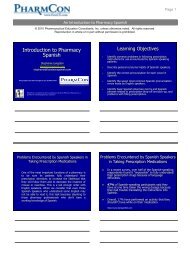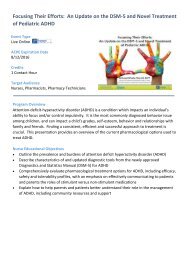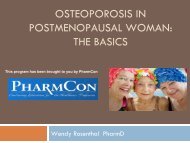Understanding and Treating Acute Coronary Syndrome - FreeCE
Understanding and Treating Acute Coronary Syndrome - FreeCE
Understanding and Treating Acute Coronary Syndrome - FreeCE
- No tags were found...
Create successful ePaper yourself
Turn your PDF publications into a flip-book with our unique Google optimized e-Paper software.
Page 1<strong>Underst<strong>and</strong>ing</strong> <strong>and</strong> <strong>Treating</strong> <strong>Acute</strong> <strong>Coronary</strong> <strong>Syndrome</strong>© 2010 Pharmaceutical Education Consultants, Inc. unless otherwise noted. All rights reserved.Reproduction in whole or in part without permission is prohibited.<strong>Underst<strong>and</strong>ing</strong> <strong>and</strong> <strong>Treating</strong><strong>Acute</strong> <strong>Coronary</strong> <strong>Syndrome</strong>Jean M. Nappi, Pharm.D., FCCP, BCPSProfessor of Clinical Pharmacy & Outcome SciencesSouth Carolina College of Pharmacy-MUSC CampusProfessor of MedicineMedical University of South CarolinaThis webcast has been supported by aneducational grant from AstraZeneca<strong>Underst<strong>and</strong>ing</strong> <strong>and</strong> <strong>Treating</strong><strong>Acute</strong> <strong>Coronary</strong> <strong>Syndrome</strong>Accreditation:Pharmacists: 0798-0000-10-064-L01-PPharmacy Technicians: 0798-0000-10-064-L01-TCE Credits: 1.0 contact hourTarget Audience: Pharmacists & Pharmacy TechniciansProgram Overview:Pharmacists can make a difference in the management <strong>and</strong> treatment of acute coronary syndrome. This program will educatepharmacists on ACS treatment guidelines, provide an update on pharmacotherapy, <strong>and</strong> the challenges associated with ACS treatment sothey can more comfortably respond to patients <strong>and</strong> providers in their role as pharmacist.Objectives:• Describe the epidemiology <strong>and</strong> etiology of acute coronary syndrome (ACS)• Outline the evidence <strong>and</strong> guideline-based role of antiplatelet therapy in the prevention of coronary attacks in patients with acutecoronary syndromes (ACS)• Describe current <strong>and</strong> emerging oral antiplatelet strategies for long-term prevention of coronary attacks in ACS patients, includingmechanisms of action, efficacy, dose <strong>and</strong> duration of therapy.• Review the pharmacist’s role in counseling patients on lifestyle changes, drug treatment strategies <strong>and</strong> medication adherence toimprove the quality of life <strong>and</strong> long-term maintenance of ACS patientsPharmCon is accredited by the Accreditation Council for Pharmacy Education as a provider of continuing pharmacyeducationLegal Disclaimer: The material presented here does not necessarily reflect the views of Pharmaceutical Education Consultants (PharmCon) or thecompanies that support educational programming. A qualified healthcare professional should always be consulted before using any therapeuticproduct discussed. Participants should verify all information <strong>and</strong> data before treating patients or employing any therapies described in thiseducational activity.1This webcast has beensupported by an educationalgrant from AstraZeneca2<strong>Underst<strong>and</strong>ing</strong> <strong>and</strong> <strong>Treating</strong><strong>Acute</strong> <strong>Coronary</strong> <strong>Syndrome</strong><strong>Acute</strong> <strong>Coronary</strong> <strong>Syndrome</strong>Speaker: Dr. Jean Nappi received her BS in Pharmacy from the State University of NY at Buffalo.She completed her Doctor of Pharmacy degree <strong>and</strong> residency in internal medicine from theUniversity of Texas at Austin / UT Health Science Center at San Antonio. Dr. Nappi has been on thefaculty at the Universities of Wisconsin, Utah, <strong>and</strong> Houston prior to her current position. She is nowProfessor of Clinical Pharmacy <strong>and</strong> Outcome Sciences in the South Carolina College of Pharmacy-MUSC Campus <strong>and</strong> Professor of Medicine (Cardiology) at the Medical University of SouthCarolina.Speaker Disclosure: Dr. Nappi has no actual or potential conflicts of interest in relation to thisprogramThis webcast has beensupported by an educationalgrant from AstraZeneca• The estimated number of hospital dischargesassociated with ACS in 2006 is 733,000 (includesMI 647,000 <strong>and</strong> unstable angina 86,000).• >1.3 million inpatient percutaneous coronaryintervention (PCI) procedures.PharmCon is accredited by the Accreditation Council for Pharmacy Education as a provider of continuing pharmacyeducationLegal Disclaimer: The material presented here does not necessarily reflect the views of Pharmaceutical Education Consultants (PharmCon) or thecompanies that support educational programming. A qualified healthcare professional should always be consulted before using any therapeuticproduct discussed. Participants should verify all information <strong>and</strong> data before treating patients or employing any therapies described in thiseducational activity.3American Heart Association Heart Disease <strong>and</strong> Stroke Statistics — 2010 Update4
Page 2<strong>Underst<strong>and</strong>ing</strong> <strong>and</strong> <strong>Treating</strong> <strong>Acute</strong> <strong>Coronary</strong> <strong>Syndrome</strong>© 2010 Pharmaceutical Education Consultants, Inc. unless otherwise noted. All rights reserved.Reproduction in whole or in part without permission is prohibited.Definitions• Unstable Angina• An ↑ in frequency <strong>and</strong> duration of ischemicepisodes caused by an imbalance of O 2 supply<strong>and</strong> dem<strong>and</strong> due to a non-occlusive thrombus• Myocardial Infarction• Irreversible tissue necrosis caused by an occlusivethrombusDefinition• <strong>Acute</strong> <strong>Coronary</strong> <strong>Syndrome</strong> (ACS)• Patients present with acute chest pain <strong>and</strong> other signs orsymptoms suggestive of myocardial ischemia.• Often not possible to determine whether the patient has orwill sustain permanent damage to the myocardium(necrosis or AMI) or has reversible ischemia (UnstableAngina).• In retrospect, after either serial ECG changes <strong>and</strong>/or serialserum markers of myocardial injury, can this distinctionbetween AMI <strong>and</strong> UA be made.• ACS is a useful concept because the triage, assessment,<strong>and</strong> initial management of UA <strong>and</strong> AMI are similar.56PathophysiologyPathophysiology• CAD atherosclerotic heart disease• Plaque rupture• Initiation of clotting cascade• Release of vasoactive substances(epinephrine, thromboxane A 2 , ADP,thrombin, etc)• Thrombus formation• Myocardial O 2 dem<strong>and</strong> > Myocardial O 2supply7 http://www.ncbi.nlm.nih.gov/bookshelf/br.fcgi?book=cardio&part=A1968
Page 3<strong>Underst<strong>and</strong>ing</strong> <strong>and</strong> <strong>Treating</strong> <strong>Acute</strong> <strong>Coronary</strong> <strong>Syndrome</strong>© 2010 Pharmaceutical Education Consultants, Inc. unless otherwise noted. All rights reserved.Reproduction in whole or in part without permission is prohibited.Consequences of ACS• Progression to myocardial infarction• <strong>Acute</strong>/chronic LV dysfunction (heart failure)• Arrhythmia• DeathAlgorithm for Initial Assessment <strong>and</strong> Evaluationof the Patient with <strong>Acute</strong> Chest PainChest pain consistent with coronary ischemiaWithin 10 minutes• 12 lead ECG, Establish continuous ECG monitoring• Establish IV with D5W• Aspirin 325 mg (chewed)• IV NTG• Blood for baseline serum cardiac markersTherapeutic/Diagnostic tracking according to 12-lead ECGNot diagnostic /normal ECGECG suggestive of ischemiaT wave inversion orST depressionST segment elevation ornew bundle branch block10ACUTE CORONARY SYNDROMEThrombogenicity of PCIThrombin GenerationNo ST Elevation(-) markers (+) markersST ElevationTissue Factor• Indirect thrombin inhibitors– Unfractionated heparin– LMWH• Direct thrombin inhibitors– Bivalirudin, argatrobanUnstable anginaNSTEMISTEMIMyocardial InfarctionPlatelet Activation• Aspirin• Thienopyridines• Glycoprotein IIb/IIIa inhibitorAdapted from Braunwald, ACC/AHA Practice GuidelinesAdhesion MoleculesVessel Wall InjuryInflammation• High dose statin1112
Page 4<strong>Underst<strong>and</strong>ing</strong> <strong>and</strong> <strong>Treating</strong> <strong>Acute</strong> <strong>Coronary</strong> <strong>Syndrome</strong>© 2010 Pharmaceutical Education Consultants, Inc. unless otherwise noted. All rights reserved.Reproduction in whole or in part without permission is prohibited.Sites of anti-thrombotic drug actionLMWHHeparinATATBivalirudinLepirudinArgatrobanTissue factorPlasma clottingFactorXacascadeProthrombinThrombinFibrinogenFibrinolyticsCollagenAspirinThromboxane A 2ADPConformationalactivation of GPIIb/IIIainhibitorsPlatelet aggregationFibrinThrombusClopidogrelPrasugrelTicagrelorTiclopidineGPIIb/IIIa1314Complications of PCIDrug Eluting Stents• Minutes to hours• Hours to days• Weeks to months• Elastic recoil• Platelet aggregation• Thrombus formation• In-stent thrombosis• In-stent thrombosis• Proliferation of vascularsmooth muscle(restenosis)• DES are commonly used in ACS <strong>and</strong> CAD patients• Add medication to locally inhibit cell proliferation• Prevent restenosis• Dual antiplatelet therapy is recommended for at least12 months following stent implantation• Increase in late AMI <strong>and</strong> death due to “in stentthrombosis”• In-stent thrombosis is a rare but potentially lethalcomplicationLancet 2003;361:247-91516
Page 5<strong>Underst<strong>and</strong>ing</strong> <strong>and</strong> <strong>Treating</strong> <strong>Acute</strong> <strong>Coronary</strong> <strong>Syndrome</strong>© 2010 Pharmaceutical Education Consultants, Inc. unless otherwise noted. All rights reserved.Reproduction in whole or in part without permission is prohibited.Patient Case POLL QUESTIONA 53 yo man presents to the ED complaining of 2 hours of chest tightness. HisECG reveals ST segment depression in the lateral leads.PMH: GERD <strong>and</strong> dyslipidemia. Medications: omeprazole 20 mg qd,atorvastatin 40 mg qd.PE: BP 134/82, HR 74, no signs of heart failure. He receives IV heparin, IVNTG, aspirin <strong>and</strong> clopidogrel <strong>and</strong> taken to cath lab later that day. He receives adrug eluting stent (Cypher) in his left circumflex artery.What medications should he receive at discharge?a. aspirin 81 mg q AM, clopidogrel 75 mg q AM , omeprazole 20 mg hs,atorvastatin 40 mg hsb. aspirin 325 mg q AM, omeprazole 20 mg hs, atorvastatin 40 mg hsc. aspirin 81 mg q AM, clopidogrel 75 mg q AM , cimetidine 400 mg bid,atorvastatin 40 mg hsd. aspirin 325 mg q AM, clopidogrel 75 mg qAM , pantoprozole 40 mg hs,atorvastatin 40 mg hsSTEMI <strong>and</strong> PCI2009 Focused Update• A loading dose of thienopyridine is recommended forSTEMI patients for whom PCI is planned. Regimens shouldbe one of the following:• At least 300 to 600 mg of clopidogrel should be given as early aspossible before or at the time of primary or nonprimary PCI. (Level ofEvidence: C)• Prasugrel 60 mg should be given as soon as possible for primaryPCI (Level of Evidence: B)• In STEMI patients with a prior history of stroke <strong>and</strong> transientischemic attack for whom primary PCI is planned, prasugrel is notrecommended as part of a dual-antiplatelet therapy regimen. (Levelof Evidence: C)17J Am Coll Cardiol 2009;54;2205-224118STEMI <strong>and</strong> PCI2009 Focused Update• The duration of thienopyridine therapy should be as follows:• In patients receiving a stent (Bare metal stent [BMS] ordrug-eluting stent [DES]) during PCI for ACS, clopidogrel75 mg daily (Level of Evidence: B) or prasugrel 10 mgdaily (Level of Evidence: B) should be given for at least12 months• If the risk of morbidity because of bleeding outweighs theanticipated benefit afforded by thienopyridine therapy,earlier discontinuation should be considered. (Level ofEvidence: C)J Am Coll Cardiol 2009;54;2205-2241 1920
Page 6<strong>Underst<strong>and</strong>ing</strong> <strong>and</strong> <strong>Treating</strong> <strong>Acute</strong> <strong>Coronary</strong> <strong>Syndrome</strong>© 2010 Pharmaceutical Education Consultants, Inc. unless otherwise noted. All rights reserved.Reproduction in whole or in part without permission is prohibited.Clopidogrel (Plavix)• Thienopyridine• Inhibits binding of ADP to the P2Y 12 receptor on theplatelet• Irreversibly inhibits platelet activation• Reduction of atherothrombotic events associated withMI, stroke, PAD, ACSDrawbacks of Clopidogrel Therapy• Pro-drug: Delayed onset of action• Genetic polymorphisms of CYP 2C19• Interaction with PPIs ?2122Risk of Adverse Outcomes AssociatedWith Concomitant Use of Clopidogrel <strong>and</strong>Proton Pump Inhibitors Following <strong>Acute</strong><strong>Coronary</strong> <strong>Syndrome</strong>Ho et al.JAMA 2009;301:937-944• Study Design• Retrospective cohort of 8205 VA ACS patients prescibedclopidogrel after dischargeOutcomePrimary:Death or ACSrehospitalizationSecondary:ACS rehospitalizationSecondary:revascularizationJAMA 2009;301:937-944Clopidogrelno PPIN = 2961Clopidogrelwith PPIN = 5244AdjustedOddsRatio95% CI20.8% 29.8% 1.25 1.11-1.416.9% 14.6% 1.86 1.57-2.2011.9% 15.5% 1.49 1.30-1.71• Main outcome measure• All cause mortality or rehospitalization for ACSSecondary:All cause mortality16.6% 19.9% 0.91 0.80-1.0523PPIs used: omeprazole, rabeprazole23
Page 7<strong>Underst<strong>and</strong>ing</strong> <strong>and</strong> <strong>Treating</strong> <strong>Acute</strong> <strong>Coronary</strong> <strong>Syndrome</strong>© 2010 Pharmaceutical Education Consultants, Inc. unless otherwise noted. All rights reserved.Reproduction in whole or in part without permission is prohibited.Stanek et alSCAI 2009Juurlink et alCMAJ 2009TRITON-TIMI38ESC 2009PACA TrialJACC 2009COGENTNEJM 2010Study DesignAdditional DataRetrospective cohortanalysis, s/p stentN=16718N=6828 on combinationNested case control, s/p MIreadmit w/MI within 90 dN=734 cases, 2057 controlsCox proportional hazardmodelN=6795 ClopidogrelN=6813 PrasugrelR<strong>and</strong>omized 104 NSTEMIpts to 2 PPIsR<strong>and</strong>omized 3761 ACS orDES patients toclopidogrel/omeprazole vsclopidogrel/placeboResults: Increasedrisk of CV eventsYes, HR = 1.51 (pooled)CI=1.39-1.64, p < 0.0001Individual agents had ↑risk, PPIs alone no ↑ riskYes, OR = 1.27 withcurrent PPIsCI=1.03-1.57No, HR = 0.94no increase with PPIcombination for eitherdrugYes, OR = 2.6CI =1.2-6.2 Plateletresponse (VASP) @ 30dto clopidogrel 150 mg/dNo, HR = 0.99CI=0.68-1.44Actually designed to lookat GI endpointPPIEsomeprazole, N=3257Omeprazole, N=2307Pantoprazole, N=1653Lansoprazole, N=785No association withpantoprazoleOR = 1.02Not specifiedNonresponders toclopidogrelOmeprazole 44%Pantoprazole 23%Special formulationcombination productused25R<strong>and</strong>omized Data: Clopidogrel or PlaceboPost-hoc analysis of the CREDO trial (N = 2116)PCI + Clopidogrel x 4 weeksPlaceboClopidogrelDeath / MI /strokeat 1 yearClopidogrel 7.7%Odds RatioClopidogrel + PPI 13.4% 1.63Placebo 11.1%Placebo + PPI 15.0% 1.55AHA Scientific Sessions 2008, abstract #399926Possible reasons for the observedincreased CV risk• PPIs interfere with the production ofthe clopidogrel active metabolite• PPIs cause direct harm• Confounders in the observational data• e.g., older, sicker patientsSummary• Observational data• Suggest an association between PPI use (particularly withomeprazole) <strong>and</strong> increased cardiovascular events in patientsreceiving clopidogrel• R<strong>and</strong>omized data, post-hoc analysis• Suggests PPI use itself is associated with increased cardiovascularevents, regardless of the presence or absence of clopidogrel• R<strong>and</strong>omized trial, COGENT study (combination product)• Did not find an increase in CV events, although it may have beenunderpoweredhttp://www.theheart.org/heartwire (accessed 6.19.09)2728
Page 8<strong>Underst<strong>and</strong>ing</strong> <strong>and</strong> <strong>Treating</strong> <strong>Acute</strong> <strong>Coronary</strong> <strong>Syndrome</strong>© 2010 Pharmaceutical Education Consultants, Inc. unless otherwise noted. All rights reserved.Reproduction in whole or in part without permission is prohibited.November 18, 2009Expert Consensus Statement• Dual antiplatelet therapy not routinely recommendedfor patients with prior ischemic stroke• Patients with prior GI bleed are at highest risk• Consider other factors: age, concurrent use ofanticoagulants or NSAIDS, <strong>and</strong> H pylori infection• PPIs are recommended for patients with a hx of upperGI bleed <strong>and</strong> may be appropriate for patients withmultiple risk factors• PPIs <strong>and</strong> H2 antagonists are not recommended forroutine use in patients at low risk29J Am Coll Cardiology, published online 11/8/1030Patient Case POLL QUESTIONPMH: GERD <strong>and</strong> dyslipidemia. Medications: omeprazole 20mg qd, atorvastatin 40 mg qd.He receives a drug eluting stent <strong>and</strong> requires dual antiplatelettherapy. Aspirin <strong>and</strong> clopidogrel were added to his regimen.What would you do?a. Discontinue omeprazole, add ranitidineb. Discontinue clopidogrel, add prasugrelc. Assess platelet reactivity with VerifyNow Assayd. Recommend genetic testingPrasugrel (Effient ® )• Thienopyridine approved July 2009• Indicated in ACS managed with PCI• Contraindicated in patients with a previous TIA or stroke• Not used in elective PCI• Benefit in patients > 75 years or < 60 kg has not beenproven (May give a lower dose (5 mg) for patients
Page 9<strong>Underst<strong>and</strong>ing</strong> <strong>and</strong> <strong>Treating</strong> <strong>Acute</strong> <strong>Coronary</strong> <strong>Syndrome</strong>© 2010 Pharmaceutical Education Consultants, Inc. unless otherwise noted. All rights reserved.Reproduction in whole or in part without permission is prohibited.Prasugrel versus Clopidogrel inPatients with <strong>Acute</strong> <strong>Coronary</strong><strong>Syndrome</strong>s (TRITON-TIMI 38)Wiviott SD, Braunwald E, et al.N Engl J Med 2007; 357: 2001-2015• Compare prasugrel with st<strong>and</strong>ard dose clopidogrel inpatients with ACS scheduled for PCI• Prospective, international, double-blind, r<strong>and</strong>omizedPrasugrel 60 mg load; 10 mg daily vsClopidogrel 300 mg load; 75 mg daily• 13,608 patients in 707 sites33• Inclusion Criteria• STEMI (n=3534)Study Population• Enrolled 12 hrs after onset of symptoms if primary PCI plannedor within 14 days after receiving treatment• Moderate to High Risk UA or NSTEMI (n=10,074)• Ischemic symptoms lasting ≥ 10 min <strong>and</strong> occurring within 72 hoursbefore r<strong>and</strong>omization• Exclusion Criteria• Increased risk of bleeding• Anemia• Thrombocytopenia• History of pathologic intracranial findings34Intervention• Choice of vessels treated, devices used <strong>and</strong>adjunctive medications was left to thediscretion of treating physicianEnd PointDeath from CV causes,nonfatal MI, or nonfatal strokeResultsPrasugrel(N=6813)Clopidogrel(N=6795)No. of patients (%)Hazard Ratiofor Prasugrel(95% CI)P Value643 (9.9) 781 (12.1) 0.81 (0.73-0.90)
Page 10<strong>Underst<strong>and</strong>ing</strong> <strong>and</strong> <strong>Treating</strong> <strong>Acute</strong> <strong>Coronary</strong> <strong>Syndrome</strong>© 2010 Pharmaceutical Education Consultants, Inc. unless otherwise noted. All rights reserved.Reproduction in whole or in part without permission is prohibited.End PointNon-CABG-related TIMImajor bleedingResultsPrasugrel(N=6741)No. of patients (%)Clopidogrel(N=6716)Hazard Ratio forPrasugrel(95%)Pvalue146 (2.4) 111 (1.8) 1.32 (1.03-1.68) 0.03Life-threatening bleeding 85 (1.4) 56 (0.9) 1.52 (1.08-2.13) 0.01Fatal Bleeding 21 (0.4) 5 (0.1) 4.19 (1.58-11.11) 0.002Major or minor TIMIbleedingBleeding requiringtransfusionCABG-related TIMI majorbleeding303 (5.0) 231 (3.8) 1.31 (1.11-1.56) 0.002244 (4.0) 182 (3.0) 1.34 (1.11-1.63)
Page 11<strong>Underst<strong>and</strong>ing</strong> <strong>and</strong> <strong>Treating</strong> <strong>Acute</strong> <strong>Coronary</strong> <strong>Syndrome</strong>© 2010 Pharmaceutical Education Consultants, Inc. unless otherwise noted. All rights reserved.Reproduction in whole or in part without permission is prohibited.Results from Genetic Testing• Increase the clopidogrel dose ?• Switch to ticlopidine or prasugrel ?• Add cilostazol ?Other Options• Use H 2 blockers (but not cimetidine)• Use prasugrel• Do genetic testing• Assess platelet reactivity with VerifyNow Assay• We don't have definitive outcome data onany of these options in clopidogrelnonresponders yet.4131Recent/Ongoing Trials• GRAVITAS (www.theheart.org)• R<strong>and</strong>omizing to high-dose vs usual-doseclopidogrel in patients ―resistant to clopidogrel‖• No significant difference in outcomes• TRIGGER PCI• r<strong>and</strong>omizing to normal dose clopidogrel orprasugrel• “resistance to clopidogrel” using VerifyNow Assay plateletreactivity units (PRU) > 23543Future antiplatelet agent• Ticagrelor (Brilinta ® , Astra Zeneca)Ticagrelor versus Clopidogrelin Patients with <strong>Acute</strong><strong>Coronary</strong> <strong>Syndrome</strong>sWallentin et al.New Engl<strong>and</strong> Journal of Medicine2009;361:1045-105744
Page 13<strong>Underst<strong>and</strong>ing</strong> <strong>and</strong> <strong>Treating</strong> <strong>Acute</strong> <strong>Coronary</strong> <strong>Syndrome</strong>© 2010 Pharmaceutical Education Consultants, Inc. unless otherwise noted. All rights reserved.Reproduction in whole or in part without permission is prohibited.PLATO Safety OutcomesTicagrelor Clopidogrel Hazard ratio(95 % CI)Major bleeding (%) 11.6% 11.2% 1.04(0.95-1.13)Life-threateningbleeding (%)5.8 5.8 1.03(0.90-1.16)Dyspnea (%) 13.8 7.8 1.84(1.68-2.02)P value0.430.73 second ventricularpause (first week) (%)5.8 3.6 0.01PLATO Summary• Pros• Significant decrease in primary endpoint in patientsmanaged with invasive <strong>and</strong> non-invasive strategies• Significant benefit observed by 30 days• No excess bleeding• Cons• No significant benefit was observed in patients living inNorth America, <strong>and</strong> those not receiving lipid loweringdrugs at r<strong>and</strong>omization• Discontinuation rates higher with ticagrelor 23.4% vs21.5% (p = 0.002)4950AspirinSecondary PreventionAll post PCI stent patients 162-325 mgwithout contraindications for at least 1month following BMS, or 12 monthsfollowing DES, then 75-162 mgindefinitely (Class I, LOE B)If higher risk of bleeding use 75-162 mg duringinitial period following stent implantation(Class IIa, LOE C)ClopidogrelSecondary PreventionFor all post PCI patients receiving a DES,75 mg daily x 12 months.If BMS: 75 mg x 1 month minimum <strong>and</strong> ideally for 12 monthsunless patient is at increased risk of bleeding(Class I, LOE B)STEMI patients not undergoing stenting, treat with clopidogrel for 14days (Class I, LOE B)Long term therapy (I year) is reasonable in STEMI patients,regardless of whether or not they undergo reperfusion therapies(Class IIa, LOE C)5152
Page 14<strong>Underst<strong>and</strong>ing</strong> <strong>and</strong> <strong>Treating</strong> <strong>Acute</strong> <strong>Coronary</strong> <strong>Syndrome</strong>© 2010 Pharmaceutical Education Consultants, Inc. unless otherwise noted. All rights reserved.Reproduction in whole or in part without permission is prohibited.Secondary PreventionBeta blockers• Start <strong>and</strong> continue indefinitely in all patients who have had MI, ACS orLV dysfunction with or without symptoms of HF unless contraindicated(Class I, LOE A)Inhibit the RAAS• ACEI if LVEF < 40% <strong>and</strong> for patients with preserved EF with HTN, DMor CKD unless contraindicated (Class I, LOE A)• Consider for all other patients who are not lower risk (Class I, LOE B)• Among lower risk patients recovering from STEMI, use of ACEI isreasonable (Class IIa, LOE B)• ARBS if intolerant to ACEI (Class I, LOE A)• Aldosterone blockade in post MI patients without significant renaldisease or hyperkalemia if: LVEF < 40% or have either DM or HF(Class I, LOE A)Secondary Prevention• Smoking Cessation• Weight Reduction BMI 18.5 to 24.9 kg/m 2• Physical Activity 30 minutes/day (minimum 5 days/week)• Dietary Changes• Blood Pressure• Lipids< 140/90 or < 130/80 if patient has DM or CKDInitiate therapy prior to dischargeLDL



